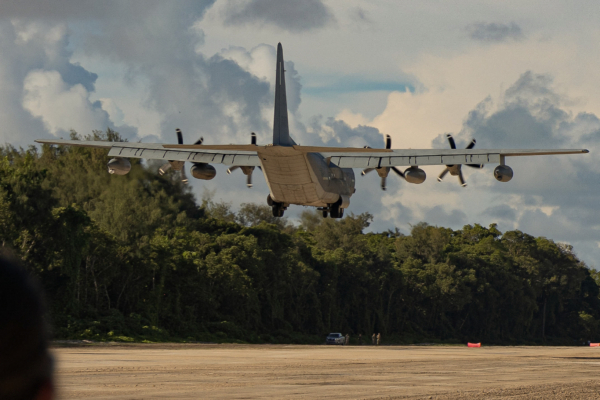In a report dated July 2, 2024, a U.S. Marine Corps aircraft landed on a refurbished runway at the old Japanese airstrip on Peleliu Island in the Pacific. Peleliu Island was the site of one of the bloodiest battles experienced by the U.S. Marine Corps during World War II, often referred to by veterans as a “nightmare” battlefield. Today, it serves as a potential base for the United States in countering strategic threats posed by the Chinese Communist Party.
According to a report by CNN on June 30, a KC-130 Hercules transport aircraft landed on the reconstructed 6,000-foot-long runway on June 22. This marked the first time such an aircraft landed at the facility since the U.S. Marine Corps recertified the airfield earlier in June.
A press release from the Marine Corps stated that this was a “significant and triumphant return to this iconic World War II site.”
“This is a historic moment as we bring a U.S. Marine Corps aircraft to land on the ‘Sledge’ runway,” said Lieutenant Colonel Christopher Romero, Commander of the Marine Corps Engineering Battalion in Palau, to the Navy Times. “This extraordinary achievement demonstrates the strategic importance of our mission and our commitment to regional stability and security.”
The reopening of the runway allows U.S. military aircraft to be deployed within 1,000 miles of Manila, Philippines. Peleliu Island is approximately 1,400 miles from Okinawa, Japan, where the 3rd Marine Division and much of the U.S. Marine Corps in the Pacific are based.
Guam, which is around 1,500 miles from the Philippines, is being heavily invested in and developed by the U.S., with plans to establish it as the home of a new Marine expeditionary force in the coming years. The next nearest major Marine expeditionary force task force is in Hawaii, over 4,600 miles away from Peleliu and Okinawa.
CNN reported that according to data from the U.S. Navy History and Heritage Command, between August and November 1944, over 1,500 U.S. soldiers and nearly 11,000 Japanese soldiers died on Peleliu Island. One U.S. unit, the 1st Marine Division, suffered a casualty rate of 70% during the six-day battle on the island.
Nearly 80 years later, the U.S. Marine Corps renamed the rebuilt landing runway as the “Sledge” runway in honor of Eugene Sledge, a Private First Class who fought in the battle on Peleliu Island as a mortarman. Sledge described Peleliu Island as a “bizarre, otherworldly, surreal nightmare, like the surface of another planet.”
The Marine Corps press release stated that the rebuilt runway now “connects the past and the future, honoring World War II sacrifices while also strengthening regional security and cooperation.”
In recent years, security in the Pacific region has been primarily focused on countering the threat posed by the Chinese Communist Party, with the Pentagon referring to the CCP as a “Pacing Threat.”
Part of mitigating the threat involves constructing military facilities to allow the U.S. to disperse assets like aircraft in the event of hostilities, including construction in the Second Island Chain, locations far enough from mainland China where CCP weaponry would have difficulty reaching.
Colonel Grant Georgulis of the U.S. Air Force wrote in a 2022 commentary on the U.S. Department of Defense website that military bases in the First Island Chain, such as Japan’s Okinawa and the Philippines, are “neither survivable nor operationally practical” due to China’s military capabilities.
“Therefore, the U.S. should prioritize locations like Midway Island, the Mariana Islands, Palau, and the Marshall Islands to complement the already fortified Guam,” wrote Georgulis.
Not only is the U.S. Marine Corps actively positioning itself in the Pacific region, but the U.S. Air Force is also engaged. Yap Island in the Federated States of Micronesia, located between Guam and Palau, is set to receive a $400 million runway extension in the Air Force’s 2025 budget. The airport on the island was a former Japanese military airstrip and is now accessible for U.S. military aircraft use.
Work is ongoing at other locations in the Second Island Chain, including the restoration of the airfields on Tinian Island in the Northern Mariana Islands, from where the U.S. bombers that dropped atomic bombs in August 1945 took off.
“The U.S. must focus laser-like on the air superiority needs of the Pacific region. The U.S. must reutilize islands gained during World War II as strategic expeditionary points in the Second Island Chain,” Georgulis wrote.
For the United States, establishing strong ties with Pacific island nations is seen as a way to deter the presence of the CCP in the region. The Biden administration signed a bilateral defense agreement with Papua New Guinea and reopened the embassy in the Solomon Islands in early 2023.
Palau signed a bilateral law enforcement agreement with the U.S. last year, allowing the U.S. Coast Guard to enforce laws within its exclusive economic zone without Palauan officers present.
U.S. Navy Secretary Carlos Del Toro visited the capital of Palau, Koror, in March of this year, stating that the U.S.’s partnership with Palau “directly supports a free and open Indo-Pacific.”
Palau President Surangel Whipps Jr. has been critical of China’s increasingly assertive behavior in the region, particularly towards Taiwan. Palau is one of the few countries to diplomatically recognize Taiwan instead of Beijing.

